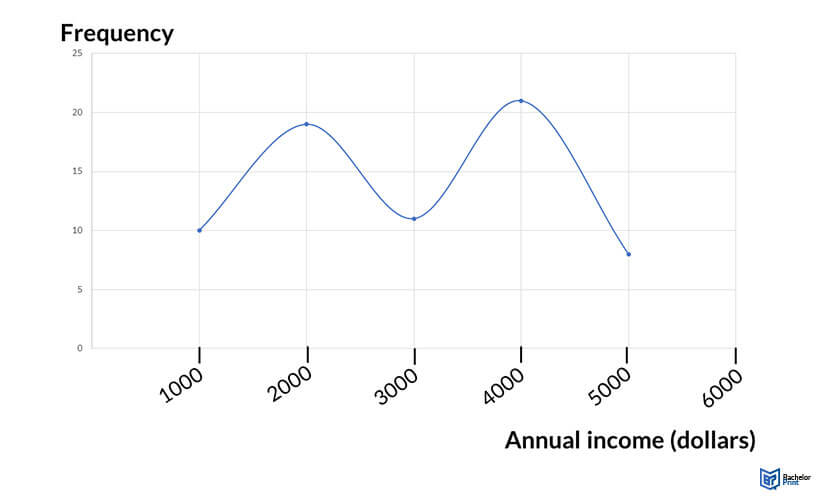
Interval data is a type of quantitative data in statistics. In the levels of measurements, it stands above ordinal data and beneath ratio data. Apart from categorizing and ordering the measurements, it also quantifies and identifies the distance between each. This indicates consistent and meaningful intervals or differences between values. A classic example of interval data is temperature measured in degrees Celsius or Fahrenheit, where intervals are consistent. Learn more in this article.
Definition: Interval data
Interval data is quantitative or numerical data measured along a numerical scale where adjacent values feature equal distance between them. The equal distances between adjacent values in interval data is called an interval. A perfect example of interval data is temperature. For instance, the difference between the values on a temperature scale is usually the same. (the interval between 90 degrees and 80 degrees Fahrenheit is the same as the one between 80 degrees and 70 degrees Fahrenheit.
Levels of measurement
Quantitative research features different levels of measurement that tell you the precise variable measurements. The levels of measurement also tell you how precisely measured data is recorded. There are four levels of measurement: nominal, ordinal, interval, and ratio data.
Nominal and ordinal data measurement levels are categorical, while interval and ratio are quantitative. This means more statistical tests can be conducted on interval and ratio data than ordinal and nominal data. The table below provides a straightforward guide on the four levels of measurement:
| Level of measurement | Features variable categories and labels | Rank order | Equal intervals between values | True zero |
| Nominal | ✓ | x | x | x |
| Ordinal | ✓ | ✓ | x | x |
| Interval | ✓ | ✓ | ✓ | x |
| Ratio | ✓ | ✓ | ✓ | ✓ |
Interval data vs. ratio data
The interval and ratio data variables are quantitative and can be subjected to several statistical tests.
Additionally, interval and ratio data variables contain categories, a rank order, and equal spacing. However, their primary difference is that ratio data contains a true zero while interval data does not.
A true zero means that there is a total absence of variables after the zero on the scale.
For example, zero is not the lowest possible temperature on Celsius and Fahrenheit interval scales. Instead, there are negative values after zero, which all have labels, equal intervals, and rankings.
On the other hand, the Kelvin temperature scale is a ratio scale because it has a true zero. So, there is nothing colder than 0 K.
Characteristics of interval data
Interval data features specific characteristics. They include the following.
| Measurement scale | Interval data is measured on an interval scale. The interval scale shows the order and direction in which the data flows. Additionally, it shows the precise difference between each value. For instance, the markings on a ruler feature the same distance between adjacent values. |
| Interval difference | The interval distance between values on an interval scale is equal and standardized. For instance, the difference between 10 and 20 degrees Fahrenheit is the same as the distance between 20 and 30 degrees Fahrenheit and all other adjacent values. |
| Negative reading | Since interval data does not have a “true zero,” negative values exist. Therefore, on a Fahrenheit temperature scale, there are negative temperature readings below 0F. |
|
Quantitativeness |
Interval data is quantitative. This means that it takes numerical values, and you can perform numerical operations on the values. This differs from categorical data, which takes numerical values without qualitative characteristics. |
|
Arithmetic operation |
You can perform arithmetic operations like addition and subtraction on interval data. However, you cannot divide or multiply it. For instance, heating a 100 F liquid at 10 degrees Fahrenheit can increase its heat to 20 degrees Fahrenheit. However, dividing 10 degrees Fahrenheit into two does not make it less hot or cold. |
Interval data analysis
The first step of analyzing interval data is gathering descriptive statistics. The frequency statistics you need for interval data analysis are:
- Frequency distribution in percentages or numerical figures
- The central tendency in mode, mean, or median
- The variability in range, standard deviation, or variance
Distribution
Begin the interval data analysis by organizing your data to visualize its distribution better. You can do this with a graph or table.

Central Tendency
There are three measures of central tendency you can use an interval data analysis.
- Mode – This is the most frequently reiterating score in your dataset.
- Median – The middle value in your dataset. The median is calculated using the formula (n+1)/2.
- Mean – The arithmetic mean value for your data’s central tendency is calculated by finding the sum of all values (Ʃx) and dividing it by the number of values (n).
Variability
Variability helps you describe how the values in your dataset are spread out. There are several ways you can calculate variability.
- Statistical range of data — This helps illustrate the difference between the lowest and highest scores in your data set.
- Standard deviation – This interval data analysis illustrates the spread of values in a data set relative to the mean. You can use specific computer programs to help you calculate the standard deviation.
- Variance – This helps to illustrate how much a spread exists between values in a dataset.
The variance is calculated as the square of the standard deviation. For example, if the standard deviation is 40, the variance is 1600.
Statistical tests
After obtaining an overview of your data, you can use various statistical tests to make meaningful inferences. The table below shows the parametric tests you can use to test hypotheses about interval data.
| Purpose | Samples/variables | Parametric test | Example |
| Mean comparisons | 2 samples | T-Test | SAT score differences for students in 2 different schools |
| Mean comparisons | 3 samples | ANOVA | SAT average differences for students from different prep programs |
| Correlation | 2 variables | Pearson’s correlation | Correlation between SAT and GPA scores |
| Regression | 2 variables | Simple linear regression | Impact of IQ on SAT scores |
Interval data: Examples
Some widely known cases of interval data are:
Printing Your Thesis With BachelorPrint
- High-quality bindings with customizable embossing
- 3D live preview to check your work before ordering
- Free express delivery
Configure your binding now!
FAQs
It is a numerical data form measured along a scale with equal intervals between each point. The intervals between adjacent values are usually standardized, depending on the scale.
It is popular in market research because it supports almost all statistical studies. Additionally, it promotes transformations in quantitative data collection.
An interval data scale does not have a true zero and may contain negative values as long as the intervals are standardized or equal. A true zero means that there are no values beyond zero.
Popular examples of this data type are SAT exams, psychological tests, and temperature scales.
